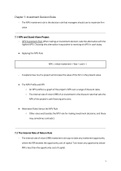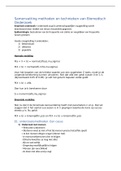Project management – a professional approach to events
Chapter 7: the project organisation
7.1 The project organisation and the permanent organisation
Many projects are realised within permanent organisations.
The figure above shows the ECH-model. This stands for Equilibrium, Coherence and Heterogeneity.
The model proceeds from the assumption that we can look at the permanent or mother organisation
in six ways. The model proceeds from the assumption that we can look at the permanent or mother
organisation in six ways. Because of the interrelation of these aspects, a change in one of the
elements will nearly always exert an influence on the other aspects.
1. Structure: the distribution of the formal and informal tasks, responsibilities and powers within
the organisational structure is visualised by means of an organisational chart.
2. Culture: the system of implicit and explicit patterns of thinking, feeling and acting, patterns which
are supported by the people who the organisation consists of.
3. Management style: the characteristic patterns of behaviour of the management at all levels
within the organisation, which arise from the understanding of one’s job and the view on
humankind and society.
4. Personnel: the type of people within the organisation and their abilities and skills, also referred
to as human capital.
5. Systems: the information and communication systems and processes within the organisation that
accommodate the functioning of the organisation: controlling and adjusting.
6. Strategy: the way in which set objectives are reached.
7.2 The organisational structure
, To bring the total set of activities of an organisation under control, the activities that more or less
cohere internally are clustered together into groups. The structure of an organisation indicated how
these organisational units relate to each other.
The embedding of the project organisation within the permanent organisation
The traditional structure of the permanent organisation is hierarchical. If there is no clarity with
reference to tasks, responsibilities and power, tensions can be a result.
The are three managerial influences that can have an effect on an employee. The functional influence
(F) refers to the development and application of the technical expertise of the employee. The
hierarchal influence (H) focuses on the employee as a subordinate. The operational influence (O) is
concerned with the concrete task that the employee is expected to fulfil.
The organisational structure of the project itself
With respect to the organisation of activities within a project, what is important is that the staffing,
tasks and responsibilities are structured. For some projects it is sufficient to summarise what the
tasks, responsibilities and powers are in what is called a schedule for the allocation of tasks. This
summary needs to be discussed with everyone concerned.
Working groups or departments focus on content-related, partial results of the project. The business
aspects of the project are executed by the project leader of his assistants. These aspects can also be
observed by team members who consider these to be their own specific tasks, or who do this in
addition to their content-related task within the project.
When there is a case of dual leadership within a project, the division of tasks, responsibilities and
powers between both leaders needs to be clearly established.
The organisational structure for multiple projects
When a number of related projects are developed and executed, they can be accommodated
organisationally within what is known as a programme structure.
When the basic shape of the organisational structure of the project itself has been determined, often
it is still necessary to establish the tasks, responsibilities and power for the individual employees.
When assigning tasks it is important to strive for an integral set of job responsibilities. When a task is
too specialised, there is a great danger of people withdrawing onto their own island and missing the
overall view on the project and the synergy between the components.
7.3 The three main characters
The three main characters in every project are the client, the agent and the project manager.
The client
We have to take into consideration that we might be dealing with both clients from outside and
clients from within the organisation. An external client rarely takes a professional view with respect
to project management. The role the client has to play, involves more than just being the initiator or
the financial backer. One can expect from a client that he is involved with the project during the
whole process. A good client should commit himself to the project emotionally and should have the
courage to take calculated risks. Whenever possible a single client is preferable. This promotes speed
and unity of control. The one who is the most obvious candidate for the position of client is the
Chapter 7: the project organisation
7.1 The project organisation and the permanent organisation
Many projects are realised within permanent organisations.
The figure above shows the ECH-model. This stands for Equilibrium, Coherence and Heterogeneity.
The model proceeds from the assumption that we can look at the permanent or mother organisation
in six ways. The model proceeds from the assumption that we can look at the permanent or mother
organisation in six ways. Because of the interrelation of these aspects, a change in one of the
elements will nearly always exert an influence on the other aspects.
1. Structure: the distribution of the formal and informal tasks, responsibilities and powers within
the organisational structure is visualised by means of an organisational chart.
2. Culture: the system of implicit and explicit patterns of thinking, feeling and acting, patterns which
are supported by the people who the organisation consists of.
3. Management style: the characteristic patterns of behaviour of the management at all levels
within the organisation, which arise from the understanding of one’s job and the view on
humankind and society.
4. Personnel: the type of people within the organisation and their abilities and skills, also referred
to as human capital.
5. Systems: the information and communication systems and processes within the organisation that
accommodate the functioning of the organisation: controlling and adjusting.
6. Strategy: the way in which set objectives are reached.
7.2 The organisational structure
, To bring the total set of activities of an organisation under control, the activities that more or less
cohere internally are clustered together into groups. The structure of an organisation indicated how
these organisational units relate to each other.
The embedding of the project organisation within the permanent organisation
The traditional structure of the permanent organisation is hierarchical. If there is no clarity with
reference to tasks, responsibilities and power, tensions can be a result.
The are three managerial influences that can have an effect on an employee. The functional influence
(F) refers to the development and application of the technical expertise of the employee. The
hierarchal influence (H) focuses on the employee as a subordinate. The operational influence (O) is
concerned with the concrete task that the employee is expected to fulfil.
The organisational structure of the project itself
With respect to the organisation of activities within a project, what is important is that the staffing,
tasks and responsibilities are structured. For some projects it is sufficient to summarise what the
tasks, responsibilities and powers are in what is called a schedule for the allocation of tasks. This
summary needs to be discussed with everyone concerned.
Working groups or departments focus on content-related, partial results of the project. The business
aspects of the project are executed by the project leader of his assistants. These aspects can also be
observed by team members who consider these to be their own specific tasks, or who do this in
addition to their content-related task within the project.
When there is a case of dual leadership within a project, the division of tasks, responsibilities and
powers between both leaders needs to be clearly established.
The organisational structure for multiple projects
When a number of related projects are developed and executed, they can be accommodated
organisationally within what is known as a programme structure.
When the basic shape of the organisational structure of the project itself has been determined, often
it is still necessary to establish the tasks, responsibilities and power for the individual employees.
When assigning tasks it is important to strive for an integral set of job responsibilities. When a task is
too specialised, there is a great danger of people withdrawing onto their own island and missing the
overall view on the project and the synergy between the components.
7.3 The three main characters
The three main characters in every project are the client, the agent and the project manager.
The client
We have to take into consideration that we might be dealing with both clients from outside and
clients from within the organisation. An external client rarely takes a professional view with respect
to project management. The role the client has to play, involves more than just being the initiator or
the financial backer. One can expect from a client that he is involved with the project during the
whole process. A good client should commit himself to the project emotionally and should have the
courage to take calculated risks. Whenever possible a single client is preferable. This promotes speed
and unity of control. The one who is the most obvious candidate for the position of client is the













